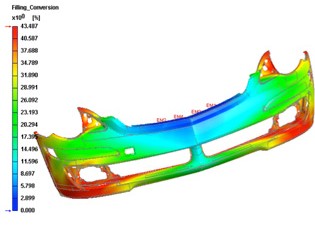Why Reactive Injection Molding?
Reactive injection molding (RIM) is similar to the conventional injection molding (IM) except thermosetting materials are used. The chemical curing reaction occurs simultaneously as the resin flows during the molding process. The polymerization of RIM is usually activated after mixing under heating with or without high pressure. The advantage of RIM is that with its relatively low viscosity, resins can readily fill the cavities with large L/D ratio. The RIM can produce plastic parts with high mechanical strength because of the crosslinking in polymer structures.
However, the thermosetting polymers are usually difficult to be recycled, and the potential problems of flashing, scorching and longer cycle time have been the main challenges of RIM. Moreover, the complicated interplay between chemical reaction, fluid flow and heat transfer bring more uncertainty on process control and optimization for RIM. Moldex3D RIM offers true 3D solutions to analyze RIM processes for thermosetting materials including unsaturated polyester, polyurethane, rubber compound, liquid silicone rubber, and epoxy molding compound. The software simulates cavity filling, curing, part warpage, fiber orientation, multi-component molding, and many other customized methods and processes.

The comparison between melt front prediction and the experimental result for a bumper made by RIM
The degree of cure at end of filling for a reaction injection molded bumper
Challenges
- Part and mold design verification and optimization to reduce manufacturing cost and design cycle time.
- Process optimization to increase part quality and product competitiveness
What Can Moldex3D Do?
Complete simulation modules include cavity filling, curing, part warpage, fiber orientation, multi-component process and interface to advanced structural analyses.
- In-depth information of melt front advancement, welding line, air trap, curing rate, velocity vectors and transfer
pressure results. - Predicts warpage by considering cure-induced (pvTC) and CTE-mismatch
- Visualizes moldbase temperature distribution and further optimize the mold heating system
- Calculates Scorch index to detect potential pre-matured curing problems for rubber compound molding or RIM with PU material.
